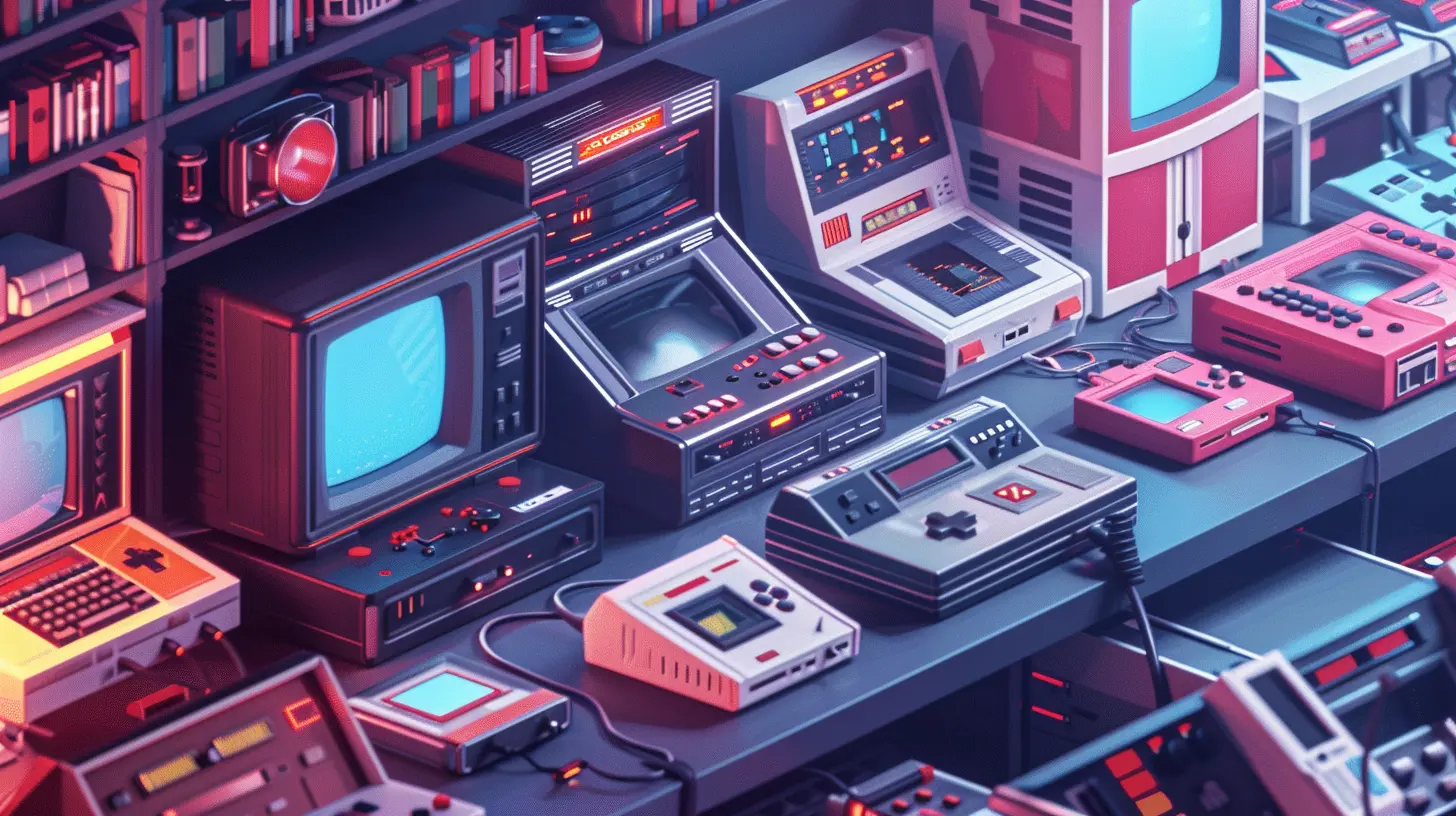A Deep Dive Into Casual Game Design and What Makes Them Tick
21 January 2025
When was the last time you found yourself tapping away furiously on your phone while waiting for the bus? Or maybe you’ve spent a lazy Sunday popping colorful bubbles on your tablet? Casual games are everywhere, and whether we admit it or not, they’ve become an integral part of our daily lives. But have you ever stopped to wonder—what makes these seemingly simple games so darn addictive? Why do millions of people across the globe willingly spend hours chasing high scores, crushing candy, or building virtual farms?
Well, buckle up because we're about to take a deep dive into casual game design. By the time you’re done reading, you’ll have a whole new appreciation for the tiny screens that keep pulling us in.
What Are Casual Games?
Before we break down the mechanics, let’s start with a simple question: What are casual games? Unlike their hardcore counterparts (think immersive RPGs and competitive shooters), casual games are designed for, well, casual play. No steep learning curves. No hundred-hour commitment. Just pick up, play, and enjoy.Casual games are typically characterized by:
- Simple Mechanics: Easy-to-understand controls and gameplay.
- Short Sessions: Quick rounds that you can squeeze into a coffee break.
- Approachability: Suitable for players of all skill levels, from a total newbie to your hyper-competitive gaming buddy.
Think of titles like Candy Crush Saga, Angry Birds, or Among Us. These are games that anyone can dive into, no matter their experience level.
The Secret Sauce of Casual Game Design
So, what makes these games tick? What’s the secret formula that hooks players and keeps them coming back for more? Let’s break it down.1. Simplicity Is Key
Good casual games don’t overwhelm players with complicated rules or mechanics. The controls are intuitive, often requiring just a tap, swipe, or drag. It’s like riding a bike—you figure it out in minutes, but it’s fun enough to keep you pedaling for hours.Take Flappy Bird, for example. Tap to keep the bird in the air and avoid obstacles. That’s it. It’s almost insultingly simple, yet this game created a global frenzy. Why? Because anyone could play it. But mastering it? That was a whole different story.
2. The Perfect Difficulty Curve
Casual games walk a fine line between being too easy and frustratingly hard. Designers carefully tune the difficulty curve so it feels just right. Early levels? A breeze to help you get the hang of things. Later levels? Challenging enough to keep you engaged.Ever notice how games like Candy Crush start with ridiculously easy levels? That’s intentional. It gives players a dopamine rush every time they complete a level while building confidence to keep going.
Game designers often use a principle called the "Flow Theory." It’s all about balance. Players should feel like they’re being challenged but not to the point where it becomes frustrating. If you’ve ever thought, “Just one more try!” after losing, you’ve been a victim of this carefully calibrated system.
3. The Role of Rewards
Rewards are the bread and butter of casual game design. Whether it’s a shiny new power-up, an in-game currency bonus, or just the satisfaction of clearing a tricky level, rewards fuel that just-one-more-round mindset.Why does this matter? Psychology. Completing tasks triggers the brain to release dopamine—a chemical that makes you feel happy. By sprinkling in constant rewards, casual games keep players feeling good and craving more.
Games like Subway Surfers or Temple Run employ rewards brilliantly. From daily challenges to unlockable characters, there are always new milestones to chase, keeping boredom at bay.
4. Engaging Visuals and Sound
Let’s face it, we’re visual creatures. Great casual games are packed with vibrant colors, eye-catching animations, and satisfying sound effects. It’s no coincidence that candy in Candy Crush looks good enough to eat or that popping bubbles in Bubble Witch Saga sounds oddly soothing.Designers go the extra mile to make every click, tap, or swipe feel rewarding. That little “ding” when you clear a level? That’s your brain cheering. It’s the gaming equivalent of patting yourself on the back.
5. Social Connectivity
Humans are social animals. Casual games capitalize on this by integrating social features that encourage friendly competition (or not-so-friendly rivalries). Whether it’s a leaderboard, the option to send a gift to a friend, or weekly tournaments, these features make the experience feel communal.Think about Words With Friends. Sure, it’s a word game, but the real fun is knowing you’re crushing your best friend in vocabulary. The social aspect adds an extra layer of engagement.
6. In-App Purchases and Monetization
Okay, we’ve got to talk about the elephant in the room—money. Most casual games are free to play, but developers still need to pay the bills. Enter in-app purchases.Energy systems, cosmetic upgrades, and premium currency are all designed to give players a taste of what they’re missing. The genius here? Players often don’t mind spending money because they’ve already invested time and effort into the game. It’s like spending a little extra on dessert—it feels worth it.
7. The Power of Habit Loops
Ever notice how some games have daily rewards or streak bonuses? That’s not a coincidence. Casual games are designed to become part of your routine. By encouraging regular check-ins, designers create habit loops that keep players coming back day after day.For example, Clash of Clans motivates players to pop in daily to collect resources or check on their base. Miss a day, and you feel like you’re falling behind. It’s subtle, but it works.
The Psychology Behind the Addiction
Let’s dig a little deeper. Why do casual games feel so addictive? It all comes down to human psychology.- Instant Gratification: Casual games deliver quick wins that satisfy our craving for immediate rewards.
- Fear of Missing Out (FOMO): Limited-time events and daily challenges tap into our fear of missing opportunities.
- Progression Systems: Whether it’s leveling up or unlocking new content, the promise of progress keeps us hooked.
Game designers understand these psychological triggers better than most. They craft experiences that tap into our basic instincts—reward, progress, and social interaction.
Are Casual Games Just Mindless Fun?
Now, some hardcore gamers might dismiss casual games as shallow or mindless. But that’s far from the truth. Behind their simple facades lies an intricate web of design principles, psychology, and creativity. In fact, designing a successful casual game is arguably harder than creating a big-budget blockbuster.Why? Because casual games must appeal to everyone. They’re not targeting die-hard gamers; they’re targeting your mom, your neighbor, your coworker—anyone with a phone and a spare minute.
The Future of Casual Games
As technology evolves, casual games are only going to get better. Augmented reality, cloud gaming, and artificial intelligence will open up new possibilities for immersive, bite-sized experiences. Imagine playing a casual AR game where your living room becomes the game board. The potential is endless.But one thing will never change: The core principles of good casual game design. Simple, fun, and addictive—that’s a formula that’ll stand the test of time.
Final Thoughts
Casual games are more than just time-killers. They’re meticulously designed experiences that tap into our psychology and create moments of joy in our otherwise hectic lives. Whether you’re crushing candies on your commute or slingshotting birds into precarious towers, there’s a profound artistry behind these seemingly simple games.So, the next time someone scoffs at your latest mobile gaming obsession, just smile and keep playing. After all, you’re not just playing a game—you’re engaging with a masterpiece of design.
all images in this post were generated using AI tools
Category:
Casual GamesAuthor:

Whitman Adams
Discussion
rate this article
9 comments
Olive McClintock
Casual games: where your free time disappears faster than your phone battery! Who knew tapping colorful buttons could lead to such emotional rollercoasters? Seriously, my thumbs need a vacation after this deep dive!
February 10, 2025 at 4:36 PM

Whitman Adams
Absolutely! Casual games have a unique way of captivating us, turning simple taps into thrilling experiences. It's amazing how they keep us engaged, even when we need a break!
Isabella Phillips
This article offers valuable insights into casual game design, breaking down key elements that engage players. It highlights essential principles while remaining clear and concise, making it a must-read for aspiring designers and enthusiasts alike.
January 27, 2025 at 5:17 PM

Whitman Adams
Thank you for your kind words! I'm glad the article resonated with you and provided useful insights into casual game design. Happy designing!
Kennedy Reese
Great insights! Understanding players truly enhances their experience.
January 27, 2025 at 3:44 AM

Whitman Adams
Thank you! I'm glad you found the insights valuable. Understanding players is key to creating engaging experiences in casual game design!
Zayla Harmon
Insightful take on design!
January 25, 2025 at 3:56 PM

Whitman Adams
Thank you! I'm glad you found it insightful!
Lark McGovern
Great insights on casual game design! It’s fascinating how simplicity can create such engaging experiences. Thank you for exploring the nuances that make these games so enjoyable!
January 24, 2025 at 4:04 AM

Whitman Adams
Thank you! I'm glad you enjoyed the exploration of simplicity in casual game design. It really is amazing how it shapes player experiences!
Fenn Duke
Ah yes, because nothing screams “deep dive” like discussing the intricate artistry of swiping left on cartoon fish. Bravo, game design wizards!
January 23, 2025 at 4:55 PM

Whitman Adams
Thanks for your feedback! Casual games often blend simplicity with creativity, making them surprisingly complex in their design.
Xavi Willis
Casual games have the power to unite players through joy and creativity! By understanding their design intricacies, we can craft experiences that delight and inspire. Let's embrace the magic of casual gaming and its endless possibilities!
January 23, 2025 at 4:51 AM

Whitman Adams
Absolutely! Casual games truly foster connection and creativity, making them a powerful medium for shared joy and inspiration in gaming.
Makayla McKenzie
Great insights! Casual games have a unique charm that brings joy and connection. Your exploration of their design truly highlights the heart of gaming. Thank you!
January 22, 2025 at 4:19 AM

Whitman Adams
Thank you for the kind words! I'm glad you enjoyed the exploration of casual games and their unique appeal. Your support means a lot!
Tempra McDonald
Great insights! Casual game design truly shapes player experiences.
January 21, 2025 at 5:01 AM

Whitman Adams
Thank you! I'm glad you found the insights valuable—casual game design really does play a crucial role in enhancing player engagement and enjoyment.
MORE POSTS

How to Keep Track of the Latest Epic Games Store Exclusive Releases

Combat Synergy: Creating the Perfect Unit Combinations

The Evolution of Combat Design in Modern Games

Home Theater Integration: The Ultimate Console Setup

Outlasting the Enemy: Endurance Strategies for Survival Games

Exploring the Modding Community Behind Stardew Valley

Epic Games Store: Tips for Managing Your Digital Game Collection